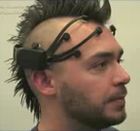التعرف على الفكر
التعرف على الفكر Thought identification، يشير إلى استخدام تكنولوجيا المثبتة تجريبيا، بطريقة ما، لقراءة أفكار البشر. وفرت الأبحاث الأخيرة باستخدام التصوير العصبي بعض البراهين المبكرة لتكنولوجيا محتملة للتعرف على high-order patterns in the brain. في بعض الحالات يمكن أن توفر هذه التقنية معلومات هامة (ومحل جدل) للمحققين.
Professor of Neuro-Psychology, Barbara Sahakian, qualifies "A lot of neuroscientists in the field are very cautious and say we can't talk about reading individuals' minds, and right now that is very true, but we're moving ahead so rapidly, it's not going to be that long before we will be able to tell whether someone's making up a story, or whether someone intended to do a crime with a certain degree of certainty."[1]
أمثلة
تعريف الأفكار
When humans think of an object, like a screwdriver, many different areas of the brain activate. This because what we call Memory is actually distributed associations throughout the brain - using the screwdriver, seeing the screw driver, etc. Psychologist Marcel Just and his colleague, Tom Mitchell, have used FMRI brain scans to teach a computer to identify the various parts of the brain associated with specific thoughts.[2]
This breakthrough technology also yielded a discovery: similar thoughts in different human brains are surprisingly similar neurologically. To illustrate this, Just and Mitchell used their computer to blindly predict, based on nothing but FMRI data, which of several images a volunteer was thinking about. The computer was 100% accurate, but so far the machine is only distinguishing between 10 images.[2]
Psychologist John Dylan-Haynes explains that FMRI can also be used to identify recognition in the brain. He provides the example of a criminal being interrogated about whether he recognizes the scene of the crime or murder weapons.[2] Just and Mitchell also claim they are able to identify kindness, hippocrisy and love in the brain.[2]
توقع النوايا
Some researchers in 2008 were able to predict with, with 60% accuracy, whether a subject was going to push a button with their left or right hand. This is notable, not just because the accuracy is better than chance, but also because the scientists were able to make these predictions up to 10 seconds before the subject acted - well before the subject felt they had decided.[3] This data is even more striking in light of other research suggesting that the decision to move, and possibly the ability to cancel that movement at the last second[4], may be the results of unconscious processing.[5]
John Dylan-Haynes has also demonstrated that FMRI can be used to identify whether a volunteer is about to add or subtract two numbers in their head.[2]
المخ كجهاز إدخال
Emotiv Systems, an Australian electronics company, has demonstrated a headset that can be trained to recognize a user's thought patterns for different commands. Tan Le demonstrated the headset's ability to manipulate virtual objects on screen, and discussed various future applications for such brain-computer interface devices, from powering wheel chairs to replacing the mouse and keyboard.[6]
قضايا أخلاقية
With brain scanning technology becoming increasingly accurate, experts predict important debates over how and when it should be used. One potential area of application is criminal law. Haynes explains that simply refusing to use brain scans on suspects also prevents the wrongly accused from proving their innocence.[1]
المصادر
- ^ أ ب The Guardian, "The brain scan that can read people's intentions"
- ^ أ ب ت ث ج 60 Minutes "Technology that can read your mind"
- ^ PMID 18408715 (PubMed)
Citation will be completed automatically in a few minutes. Jump the queue or expand by hand - ^ Kühn, S., & Brass, M. (2009). Retrospective construction of the judgment of free choice.Consciousness and Cognition, 18, 12-21.
- ^ Matsuhashi, M., & Hallett, M. (2008). The timing of the conscious intention to move. European Journal of Neuroscience , 28, 2344-2351.
- ^ Tan Le: A headset that reads your brainwaves


